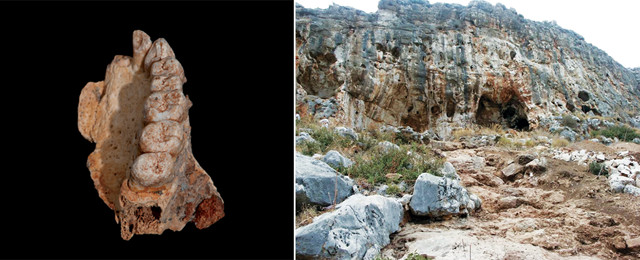
by Mary Caperton Morton Tuesday, May 1, 2018

Close-up view of the human jawbone fossil found in Misliya Cave in northern Israel, showing details of the crown topography and dental features. Credit: both: Rolf Quam/Binghamton University.
The recent discovery of a jawbone belonging to Homo sapiens, and associated stone tools, in Israel may push back the timing of the earliest human migration out of Africa by as much as 50,000 years.
To date, the oldest human remains found outside of Africa are thought to be 90,000 to 120,000 years old. But a set of eight teeth encased in a partial upper jawbone found in Misliya Cave in northern Israel has been found, using three independent dating methods, to be between 177,000 and 194,000 years old. Stone tools located nearby were carved using the sophisticated Levallois technique, a distinctive style of flint knapping, suggesting that the emergence of the technology may coincide with the earliest human migrations out of Africa.
Decades of excavations at Misliya Cave, near Mount Carmel, Israel, have turned up early-human evidence — such as tools, animal bones and fire rings — suggesting more than 100,000 years of human occupation at the site. But the jawbone represents the first human remains found there, the team led by Israel Hershkovitz of Tel Aviv University wrote in Science.
The revised timeframe, with humans leaving Africa at least 55,000 years earlier than previously thought, is consistent with recent genetic studies that suggest modern humans might have migrated from Africa as early as 220,000 years ago. It also dovetails with evidence uncovered in China and across western Asia that H. sapiens may have overlapped — and interbred — with Neanderthals and other hominin species for much longer than previously thought, according to a perspective written by Chris Stringer, a paleoanthropologist at the Natural History Museum in London, in the same issue of Science.
“Misliya is an exciting discovery,” said study co-author Rolf Quam of Binghamton University in New York, in a statement. “It provides the clearest evidence yet that our ancestors first migrated out of Africa much earlier than we previously believed. It also means that modern humans were potentially meeting and interacting during a longer period of time with other archaic human groups, providing more opportunity for cultural and biological exchanges.”
© 2008-2021. All rights reserved. Any copying, redistribution or retransmission of any of the contents of this service without the expressed written permission of the American Geosciences Institute is expressly prohibited. Click here for all copyright requests.